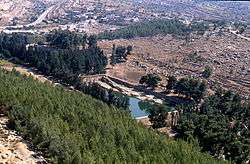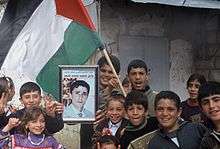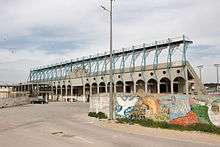al-Khader
al-Khader (Arabic: الخضر) is a Palestinian town in the Bethlehem Governorate in the south-central West Bank. It is located 5 kilometers (3.1 mi) west of Bethlehem. According to the Palestinian Central Bureau of Statistics, the town had a population of 11,856 in 2017.[2] The area around al-Khader is marked by vineyards, and olive and fig trees.[3]
al-Khader | |
|---|---|
Municipality type B | |
| Arabic transcription(s) | |
| • Arabic | الخضر |
| • Latin | al-Khadr (official) |
 Eastern al-Khader and Solomon's Pools | |
 al-Khader Location of al-Khader within Palestine | |
| Coordinates: 31°41′34″N 35°09′59″E | |
| Palestine grid | 162/124 |
| State | State of Palestine |
| Governorate | Bethlehem |
| Government | |
| • Type | Municipality |
| • Head of Municipality | Ramzi Salah |
| Area | |
| • Total | 19,882 dunams (19.9 km2 or 7.7 sq mi) |
| Population (2017) | |
| • Total | 11,856 |
| • Density | 600/km2 (1,500/sq mi) |
| Name meaning | "the [town] of Saint George"[1] |
Monastery of St. George, Solomon's Pools and Al-Hamadiyya Mosque are all located in al-Khader.
History
The site of al-Khader was first inhabited by the Canaanites. In 1953, five arrowheads of javelins dating from the 11th century BCE, were discovered in al-Khader with Canaanite inscriptions. The translations were "dart of 'Abd Labi't".[4] The script used is one of the earliest known examples of a phonetic alphabet and the find suggests al-Khader was a site of military importance around 1000 BCE.[5]
Al-Khader is named after Saint George who in Arab culture is known as "al-Khadr." According to local tradition, Saint George was imprisoned in the town of al-Khader where the current Monastery of St. George stands. The chains holding him were relics that were said to hold healing power.[6]
During the Crusader era, the village, called Casale S. Georgii, was granted by Geoffrey de Tor to the church in Bethlehem, and included in its possessions in 1227 and 1266.[7]
Around 1421/1422 CE the Church of St. George was mentioned by Western traveler John Poloner as situated on a hill near Bethlehem.[8][9]
Ottoman era
During late Ottoman rule (1516-1917), al-Khader was part of the political-administrative sheikdom and nahiyah ("subdistrict") of Bani Hasan, which was ruled by the Absiyeh family of al-Walaja. In 1838 its inhabitants were classified as Muslims by the English scholars Edward Robinson and Eli Smith, part of the Beni Hasan District, west of Jerusalem.[10][11] In 1863 Victor Guérin found the village "reduced to two hundred inhabitants, almost all Muslims." He further noted remains of constructions, with rather large stones, which he thought were dated from an era prior to the Arab conquest.[12]
Albert Socin notes that an official Ottoman village list from about 1870 documented el-chadr with a population of 122 in a total of 43 houses, though that population count only included men. It was further noted that the small Greek monastery served as a mental asylum.[13][14]
In 1882, the PEF's Survey of Western Palestine described al-Khader as a moderate-sized village with a "Greek church and convent." It was surrounded by vineyards and olive groves and "rock-cut tombs" were situated to the north of the village.[9] It had a mixed population of Muslims and Greek Orthodox Christians, according to the Survey of Western Palestine.[9]
In 1896 the population of El-chadr was estimated to be about 210 people.[15]
British Mandate era
In the British Mandate 1922 census of Palestine, al-Khader had a population of 697; 694 Muslims and 3 Christians.[16] By the 1931 census of Palestine, the population was 914, mostly Muslim with three Christian inhabitants.[17]
In the 1945 statistics the town had 1,130 Muslim inhabitants[18] and a total land area of 20,100 dunams. It was a part of the Jerusalem District.[19] Of the land, 5,700 dunams were irrigated or used for plantations, 5,889 dunams were for cereals,[20] while 96 dunams were built-up (urban) land.[21]
The Orthodox Christian Church owns several hundreds of dunams made up of vineyards, olive groves and field crops. The lands were entrusted to them since the Rashidun era during the caliphate of Umar who presided over the conquest of Palestine in the 630s. Most of the land is leased to Muslim farmers.[22]
Jordanian era
In the wake of the 1948 Arab–Israeli War, and after the 1949 Armistice Agreements, al-Khader came under Jordanian rule. It was annexed by Jordan in 1950.
In 1961, the population of Khadr was 1,798.[23]
Post 1967
Since the Six-Day War in 1967, al-Khader has been under Israeli occupation. The population in the 1967 census conducted by the Israeli authorities was 2,051.[24]
After the 1995 accords, 9% of al-Khader's land was classified as Area A land, 5.5% as Area B, and the remaining 85.5% as Area C.[25]
Israel has confiscated land from al-Khader in order to construct two Israeli settlements:
In 1997, the PCBS recorded a population of 6,802 of which 3,606 were males and 3,196 were females.[26] Unlike many Palestinian towns in the area, refugees and their descendants do not have a substantial population in al-Khader. In 1997, 5.2% of the town's inhabitants were recorded as refugees.[27] In the 2007 PCBS census, al-Khader had a population of 9,774.[2]
Since the construction of the Israeli West Bank barrier around al-Khader, several thousand dunams of farmland have been separated from the village, with the inhabitants unable to access them without a permit. In 2006, 50 villagers protested the barrier by filling bags with grapes and selling them along Route 60. Israeli soldiers and police attempted to quell protesters resulting in the injuries and detainment of two residents.[28]
In April 2015 villagers blocked work by settlers to create a bypass road for access to an illegal outpost, which, if completed, would alienate a further 400 dunams of village land.[29]
Geography and land
The older part of al-Khader is situated on a saddle-shaped hill facing a steep ridge to the south and open areas to the north, in the central highlands of the West Bank.[9] Nearby localities include the Dheisheh Refugee Camp adjacent to the east, the village of Artas further to the east, Beit Jala to the northeast, al-Walaja and the Israeli settlement of Har Gilo to the north, Battir and Husan to the northwest, Nahalin and the Israeli settlements of Beitar Illit to the west, Neve Daniel to the southeast, and Elazar to the south.
Culture

Religious sites
The Orthodox Christian Monastery of St. George and Solomon's Pools are located in al-Khader and are main tourist attractions.[30] Palestinian Christians from Bethlehem, Beit Sahour and Beit Jala and Muslims from al-Khader flock to the monastery to celebrate the Feast of Saint George in early May. Solomon's Pools, named after Suleiman the Magnificent the tenth Sultan of the Ottoman Empire, were built by the Romans under Herod the Great to provide water for the aqueduct built to supply water to Bethlehem and Jerusalem where it terminated under the Al-Aqsa Mosque.[31] Al-Khader's main and oldest mosque is the al-Hamadiyya Mosque. According to the International Middle East Media Center, in 2007, it was burned down by Israeli settlers. The mosque is about 700 years old and was restored by the Tourism Ministry of the Palestinian National Authority.[32]
Cultural festivals

Al-Khader is also well known in the area for its peaches, grapes and apples. It hosts its annual Grape Festival every September. The festival was initiated by the al-Khader municipality to promote the town's primary agricultural product, grapes. Other exhibitions held at the festival include one on embroidery and knitting, a local heritage exhibition of mills, grinders, and harvest tools, and an exhibition of home-made grape products such as dibs (molasses made from grapes).[33] Al-Khader Stadium which holds a capacity of 6,000 is located in the town.
Government
Al-Khader is governed by a municipal council of thirteen members including the mayor. In the 2005 municipal elections, the Hamas-affiliated Reform list won the most seats (five), while the Fatah-affiliated Falasteen al-Ghad list won four seats. Two independent lists — Al-Aqsa and Abnaa al-Balad — each won two seats.[34]
References
- or “The green old man”, Palmer, 1881, pp. 299, 28
- 2017 PCBS Census Palestinian Central Bureau of Statistics.
- Al-Khader Old Core. The Centre for Cultural Heritage Preservation.
- Drews, Robert. (1993). The End of the Bronze Age: Changes in Warfare and the Catastrophe Ca. 1200 BC Princeton University Press, p.189. ISBN 0-691-02591-6.
- Blincoe, Nicholas (2017) Bethlehem. Biography of a Town Constable. London ISBN 978-1-4721-2866-9. pp. 40,41
- Sennott, Charles M. (2001). The Body and the Blood: The Holy Land's Christians at the Turn of a New Millennium : a Reporter's Journey PublicAffairs, p.397. ISBN 1-891620-95-9.
- Röhricht, 1893, RRH, pp. 258-260, No 983; cited in Pringle, 1993, pp. 295-296
- Poloner, 1894, p. 18
- Conder and Kitchener, 1883, SWP III, p. 26
- Robinson and Smith, 1841, vol 2, p. 325
- Robinson and Smith, 1841, vol 3, Appendix 2, p. 123
- Guérin, 1869, pp. 310-312
- Socin, 1879, p. 149
- Hartmann, 1883, p. 148
- Schick, 1896, p. 125
- Barron, 1923, Table VII, Sub-district of Bethlehem, p. 18
- Mills, 1932, p. 36
- Government of Palestine, Department of Statistics, 1945, p. 25
- Government of Palestine, Department of Statistics. Village Statistics, April, 1945. Quoted in Hadawi, 1970, p. 57 Archived 2011-06-04 at the Wayback Machine
- Government of Palestine, Department of Statistics. Village Statistics, April, 1945. Quoted in Hadawi, 1970, p. 103 Archived 2016-03-03 at the Wayback Machine
- Government of Palestine, Department of Statistics. Village Statistics, April, 1945. Quoted in Hadawi, 1970, p. 153 Archived 2016-03-03 at the Wayback Machine
- Kark, Ruth. (2001). Jerusalem and Its Environs: Quarters, Neighborhoods, Villages, 1800-1948 Wayne State University Press, p. 199. ISBN 0-8143-2909-8.
- Government of Jordan, Department of Statistics, 1964, p. 23
- Perlmann, Joel (November 2011 – February 2012). "The 1967 Census of the West Bank and Gaza Strip: A Digitized Version" (PDF). Levy Economics Institute. Retrieved 24 June 2016.
- Al Khader Town Profile, p. 20, ARIJ
- Palestinian Population by Locality, Sex and Age Groups in Years Archived 2012-01-11 at the Wayback Machine Palestinian Central Bureau of Statistics (PCBS).
- Palestinian Population by Locality and Refugee Status Archived 2008-11-18 at the Wayback Machine Palestinian Central Bureau of Statistics (PCBS).
- Palestinians, Israelis and Internationals `armed` with grapes arrested and beaten near Bethlehem International Solidarity Movement. 2006-08-10.
- 'Land threatened by settler outpost near Bethlehem,' Ma'an News Agency 11 April 2015.
- al-Khader Centre of Cultural Heritage of Preservation.
- Solomon's Pools Bethlehem Homepage, Geocities. Archived 2009-10-24.
- Mosque near Bethlehem burned down by Israeli settlers Bannoura, Said, International Middle East Media Center. 2008-01-02. Archived January 6, 2008, at the Wayback Machine
- The Grape Festival Centre of Cultural Heritage of Preservation.
- Local Elections (Round Three)- Successful lists by local authority and No. of votes obtained Archived 2008-10-31 at the Wayback Machine Central Elections Commission - Palestine, p.9.
Bibliography
- Barron, J.B., ed. (1923). Palestine: Report and General Abstracts of the Census of 1922. Government of Palestine.
- Conder, C.R.; Kitchener, H.H. (1883). The Survey of Western Palestine: Memoirs of the Topography, Orography, Hydrography, and Archaeology. 3. London: Committee of the Palestine Exploration Fund.
- Government of Jordan, Department of Statistics (1964). First Census of Population and Housing. Volume I: Final Tables; General Characteristics of the Population (PDF).
- Government of Palestine, Department of Statistics (1945). Village Statistics, April, 1945.
- Guérin, V. (1869). Description Géographique Historique et Archéologique de la Palestine (in French). 1: Judee, pt. 3. Paris: L'Imprimerie Nationale.
- Hadawi, S. (1970). Village Statistics of 1945: A Classification of Land and Area ownership in Palestine. Palestine Liberation Organization Research Center. Archived from the original on 2018-12-08. Retrieved 2008-09-20.
- Hartmann, M. (1883). "Die Ortschaftenliste des Liwa Jerusalem in dem türkischen Staatskalender für Syrien auf das Jahr 1288 der Flucht (1871)". Zeitschrift des Deutschen Palästina-Vereins. 6: 102–149.
- Mills, E., ed. (1932). Census of Palestine 1931. Population of Villages, Towns and Administrative Areas. Jerusalem: Government of Palestine.
- Palmer, E.H. (1881). The Survey of Western Palestine: Arabic and English Name Lists Collected During the Survey by Lieutenants Conder and Kitchener, R. E. Transliterated and Explained by E.H. Palmer. Committee of the Palestine Exploration Fund.
- Poloner, John (1894). John Poloner's description of the Holy Land (ca. A.D. 1421). Palestine Pilgrims' Text Society.
- Pringle, Denys (1993). The Churches of the Crusader Kingdom of Jerusalem: A-K (excluding Acre and Jerusalem). I. Cambridge University Press. ISBN 0 521 39036 2.
- Robinson, E.; Smith, E (1841). Biblical Researches in Palestine, Mount Sinai and Arabia Petraea: A Journal of Travels in the year 1838. 2. Boston: Crocker & Brewster.
- Robinson, E.; Smith, E. (1841). Biblical Researches in Palestine, Mount Sinai and Arabia Petraea: A Journal of Travels in the year 1838. 3. Boston: Crocker & Brewster.
- Röhricht, R. (1893). (RRH) Regesta regni Hierosolymitani (MXCVII-MCCXCI) (in Latin). Berlin: Libraria Academica Wageriana.
- Schick, C. (1896). "Zur Einwohnerzahl des Bezirks Jerusalem". Zeitschrift des Deutschen Palästina-Vereins. 19: 120–127.
- Socin, A. (1879). "Alphabetisches Verzeichniss von Ortschaften des Paschalik Jerusalem". Zeitschrift des Deutschen Palästina-Vereins. 2: 135–163.
External links
- Welcome To al-Khadr
- Al-Khader, Welcome to Palestine
- Survey of Western Palestine, Map 17: IAA, Wikimedia commons
- El-Khader - Bethlehem This Week in Palestine. 2008-12-05.
- Al Khader Town (Fact Sheet), Applied Research Institute–Jerusalem (ARIJ)
- Al Khader Town Profile, ARIJ
- Al Khader aerial photo, ARIJ
- The priorities and needs for development in Al Khader town based on the community and local authorities’ assessment, ARIJ
